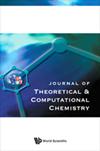卵黄蛋白和异卵黄蛋白对SGLT2的体外活性及计算机模拟
IF 2.4
Q3 Computer Science
Journal of Theoretical & Computational Chemistry
Pub Date : 2019-11-01
DOI:10.1142/s0219633619500354
引用次数: 2
摘要
采用hSGLT2(人钠依赖性葡萄糖共转运蛋白2)的同源性模型作为糖尿病的靶点。以达格列净为阳性对照,对牡荆素-和异牡荆素- sglt2配合物进行分子对接和动力学模拟。结果表明,与达格列净相比,牡荆素和异牡荆素的结合能较弱,表明这两种配体可能通过抑制SGLT2而表现出较弱的抗糖尿病作用。牡荆素和异牡荆素的结合方式较差,可能是其抗糖尿病作用较弱的原因。这些结果与体外对hSGLT2的抑制活性一致,在10剂量下,牡荆素的抑制率为26.3%,异牡荆素的抑制率为11.2%[公式:见文][公式:见文]mol[公式:见文][公式:见文][公式:见文][公式:见文]L[公式:见文]。计算和体外实验的结果可能解释牡荆素和异牡荆素对SGLT2可能的抑制机制,从而加深我们对SGLT2抑制剂构效关系的认识。本文章由计算机程序翻译,如有差异,请以英文原文为准。
In silico modeling and in vitro activity of vitexin and isovitexin against SGLT2
The homology model of hSGLT2 (human sodium dependent glucose co-transporter 2) was used as a target for diabetes mellitus. Molecular docking and dynamics simulations were carried out on vitexin- and isovitexin-SGLT2 complexes with dapagliflozin as positive control. The results show that both vitexin and isovitexin have weaker binding energies compared to dapagliflozin, indicating that both ligands may exhibit weak anti-diabetic effects through inhibiting SGLT2. The poor binding mode of vitexin and isovitexin may be responsible for their weak anti-diabetic effect. These results are in accordance with the inhibitory activity against hSGLT2 in vitro test with the inhibitory rate 26.3% of vitexin and 11.2% of isovitexin at the dose of 10[Formula: see text][Formula: see text]mol[Formula: see text][Formula: see text][Formula: see text]L[Formula: see text]. The results of calculation and in vitro test may explain the possible inhibiting mechanism of vitexin and isovitexin against SGLT2, and therefore enhance our understanding of the structure-activity relationships of SGLT2 inhibitors.
求助全文
通过发布文献求助,成功后即可免费获取论文全文。
去求助
来源期刊
CiteScore
1.70
自引率
0.00%
发文量
0
审稿时长
3 months
期刊介绍:
The Journal of Theoretical and Computational Chemistry (JTCC) is an international interdisciplinary journal aimed at providing comprehensive coverage on the latest developments and applications of research in the ever-expanding field of theoretical and computational chemistry.
JTCC publishes regular articles and reviews on new methodology, software, web server and database developments. The applications of existing theoretical and computational methods which produce significant new insights into important problems are also welcomed. Papers reporting joint computational and experimental investigations are encouraged. The journal will not consider manuscripts reporting straightforward calculations of the properties of molecules with existing software packages without addressing a significant scientific problem.
Areas covered by the journal include molecular dynamics, computer-aided molecular design, modeling effects of mutation on stability and dynamics of macromolecules, quantum mechanics, statistical mechanics and other related topics.

 求助内容:
求助内容: 应助结果提醒方式:
应助结果提醒方式:


